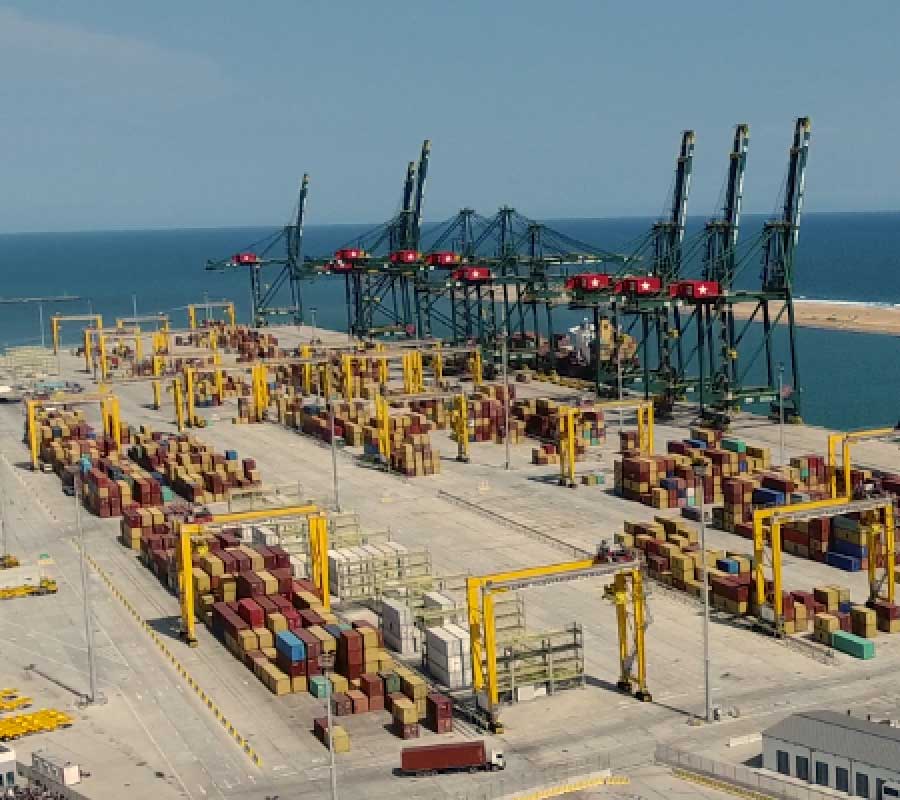All about the Autonomous Port of Lomé and its various activities

Like any coastal nation, Togo has been able to take advantage of a particular advantage offered by nature. The Gulf of Guinea, part of the Atlantic Ocean which runs along the southern end of this country of 8.6 million inhabitants, is not just a tourist asset. It is also an economic asset, the main jewel of which is the Port Autonome de Lomé (PAL). Inaugurated in 1868 and then renovated over the years with the addition and strengthening of the docks, this platform desert not only Togo but also the entire sub-region and even beyond.
Considered as the only deep-water port in the West African sub-region, the autonomous port of Lomé does not fail in its reputation. In 2020, the Autonomous Port of Lomé was still the first container port in West Africa with 1.5 million twenty-foot equivalent units (TEU) and 25 million tonnes of goods that passed through during the year. Reports which make it 5th on the continental scale and 99th globally in the batch of the first 120 ports out of 500.
In view of all these figures, Togo, a country whose coast shelters it even economically depends on it, as well as the landlocked countries of the sub-region such as Burkina Faso, Mali or Niger. In 2019 for example, the revenues of the Autonomous Port of Lomé accounted for 60% of the national income. This figure is justified by the growth in exchanges that take place every day between the various players in the sector.
It should be noted at the outset that the Autonomous Port of Lomé is also a set of fields of activity which complement each other for the sake of competitiveness. One can quote among others the industrial free zone which has as support the PAL and the recently renovated fishing port which also counts somewhat in the balance.
But the commercial aspect of import and export obviously takes precedence and it is on the commercial activities of the port that this article will focus. But what are these different complementary activities that have made the autonomous port of Lomé a powerful economic hub for several years. From the general administration of this state-owned company to the dockers through the Ship Chandlers, it is a chain of work that follows one another 24 hours a day to ensure the continuity of economic activity.
It will be very impossible to go into the details of all the activities and micro-activities that make up this whole, but some are found to be main.
Handling :
Ships often carry tons of goods on board. Both for loading and unloading, the handlers intervene to ensure the work. The men in the field who are a visible part of the port apparatus are generally also called dockers. Most often they use machinery specially reserved for handling goods which can be classified as heavy goods vehicles. Cranes, forklifts and the like are heavily used in these areas. There are also manual labor that falls on them in some cases. Since handling is generally a contractual activity with other companies, there is a wide range of them at the Port Autonome de Lomé.
Transportation:
After handling and even before, the goods deserve to be conveyed to the place of arrival or departure. This is where the carriers come in, who are also helped by the handlers. The latter only move goods on site or load them to carriers who in turn provide long journeys. They are generally heavy goods vehicles with experienced drivers who work on behalf of an intermediary company or directly for any client. If the ships provide maritime transport, the carriers have control over the land route. And it is also an activity that is very visible at the Autonomous Port of Lomé.
Logistic:
The first two points vaguely resemble activities that complement each other. But all this must follow a given order and rhythm. There are several conditions to consider before, during and after performing these tasks and also depending on a ton of criteria. All these analyzes and all this organization which must allow these tasks to be carried out successfully falls on logistics. Logistics companies therefore naturally intervene in the chain at the Port Autonome de Lomé. Their mission can be summed up in the establishment of operational and strategic means aimed at optimizing the port chain.
Forwarders:
Also in the sense of organization, the forwarder is a direct intermediary of the sender or recipient of a given commodity. Its role often begins even well before the expedition; which gives it a vocation on import-export. He also ensures part of the transport but also manages the administrative formalities with the authorities that govern the port. If the forwarder is assimilated to the customs declarant, he can also come into contact with the commercial outlets or the customs authorities.
Customs:
A seaport is in its essence the face of importation as well as exportation in all countries. And these two phases of international trade are subject to rules. They differ from country to country, but the basic model remains the same. Any imported product is naturally subject to customs duties generally calculated on the basis of its market value. This is an important condition before the cargo leaves the port facilities. The customs services installed on site ensure scrupulous compliance with these financial requirements. These customs duties also constitute a large part of the port’s revenue and more precisely 80% in 2019 for the Autonomous Port of Lomé. Customs also ensure the nature of the goods imported or exported according to national and international law.
Ship Chandler:
It is an activity that combines handling, transport and logistics, as well as direct purchases and sales. It’s hard to talk about a safe journey for a ship without talking about the Ship Chandling. The latter, whose activity is an integral part of the port chain, are also on the front line. They are responsible for supplying the ships with food, equipment and even fuel on departure and arrival. Whether for commercial vessels or boats of convenience, the Ship Chandlers ensure a safe trip on the sea. They do the shopping in the place of the captains or boat owners and take care of the delivery in precise time. At the Autonomous Port of Lomé, Uni-Commercial is brilliantly illustrated in the field of Ship Chandling. Many safe cruises bear the imprint of this company that knows what it takes to face the seas.
The Port Administration:
It is the governing body of the port which covers all the main activities as well as intermediaries. This goes from the Board of Directors to the Chief Executive Officer, including the Chief Operating Officer and the Supervisory Board. The management positions within the administration which can be counted by dozens and this depending on the very specific and important tasks incumbent on them. At the Autonomous Port of Lomé, Rear Admiral Fogan Kodjo ADEGNON has held the position of Director General since 2005.







